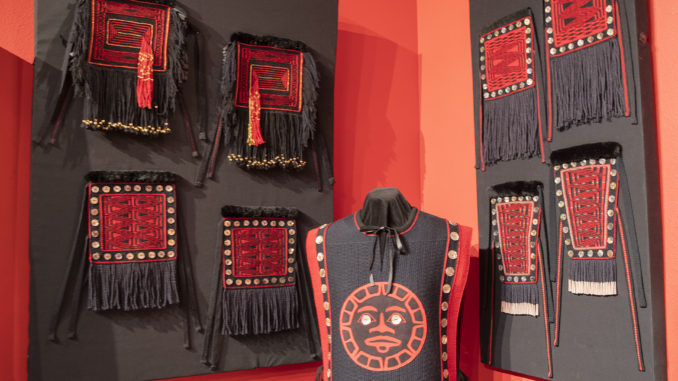
Ancient patterns and modern weaving on display in Longhouse
“The art of weaving is a profound metaphor for understanding the workings of the universe and our place in it. Through the physical process of weaving, we gain a better understanding of this world and how we as human beings are woven into it,” Susan Barrell Merritt, “The Art of Weaving a Life.”
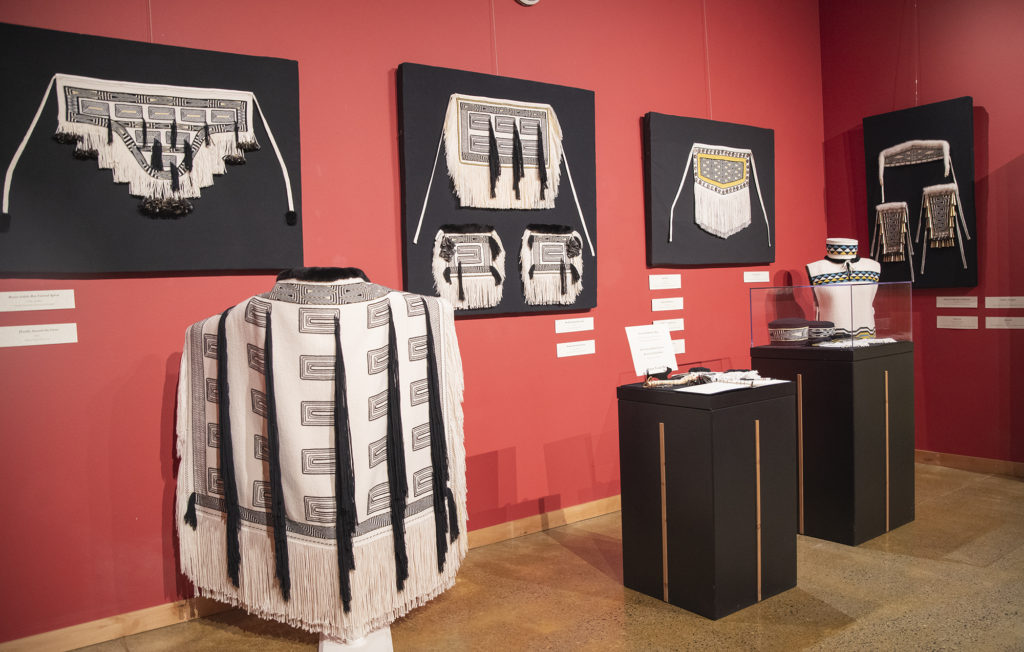
Photos & story by Emily Matthiessen
Throughout human history weaving has been an essential domestic skill and a symbol of the deeper, more mysterious aspects of life. How the symbols are interpreted, and with what emphasis, depends upon the culture the weaving has been developed by, but could there be a complex pattern that connects all weavers, and thus their communities, through time?
The current exhibition in the Peninsula College House of Learning, ʔaʔk̓ʷustəƞáwt̓xʷ , Longhouse, is a tangible connection between weavers of the past, the present, and the future. It features the Ravenstail and Chilkat weavings of Kay Field Parker, a master weaver and teacher highly involved in the revival of Ravenstail weaving, which lay dormant for over 200 years.
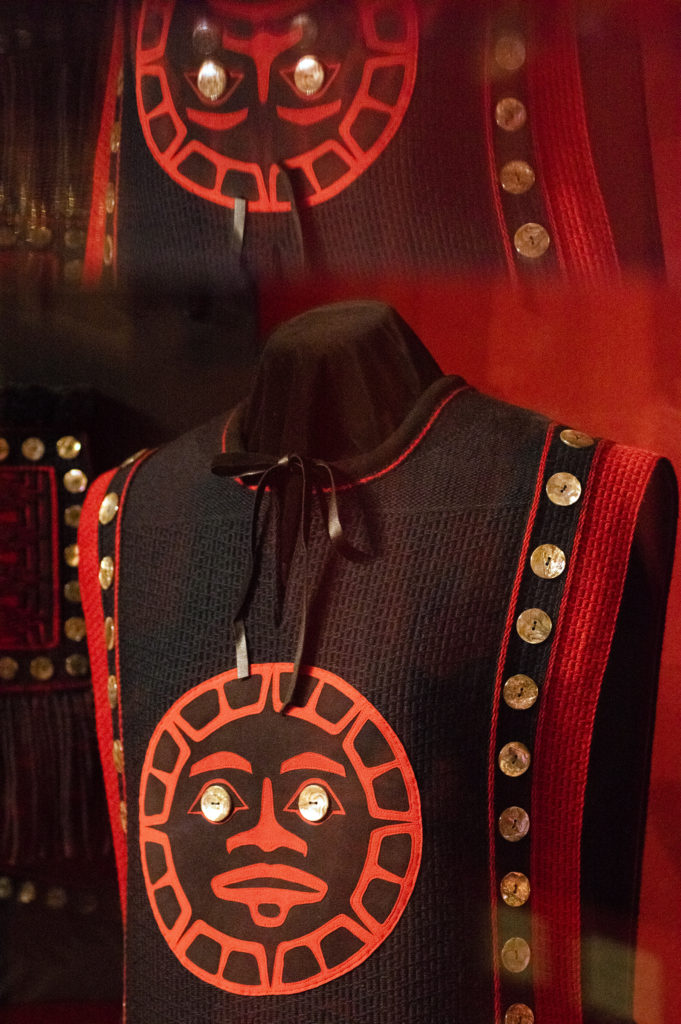
Parker’s teacher, Cheryl Samuel, is credited with rediscovering the techniques necessary to create the Ravenstail weavings of the Pacific Northwest Coast. Once they were reintroduced, an ever-expanding group of weavers have learned, collaborated, and taught the skills.
Parker visited the Port Angeles campus in January and gave a presentation in the Studium Generale, a free lecture series open to the public. “This program was made possible through generous contributions to the PC Foundation by a couple who wishes to remain anonymous,” said Kate Reavey, Studium Generale Instructor. “These donors have created this op- portunity as well as other programming that required additional funding. We are deeply grateful!”
Kay Parker detailed some of the history of the Chilkat and Ravenstail weaving and its rejuvenation, her own history of learning and weaving, the technical aspects of the weaving, and the process the ancient weavers used to gather and dye the mountain goat fibers previously used. This and other Studium Generale lectures are recorded and available for viewing in the library. Parker has returned to her home in Juneau, Alaska, but her work remains in the Longhouse until March 27th.
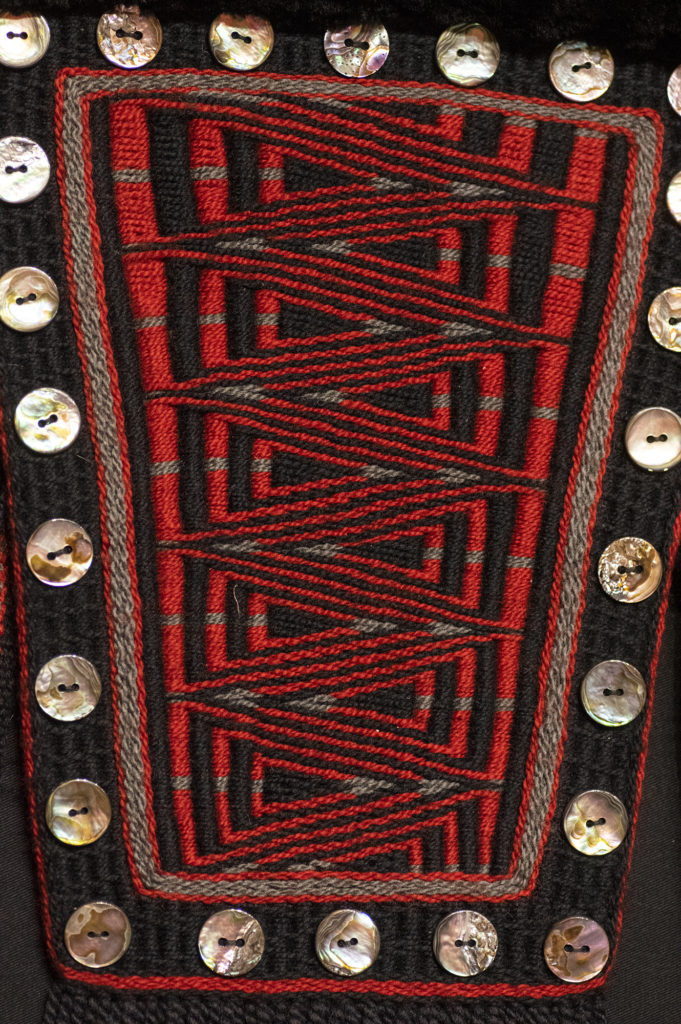
Weaving is a contemplative practice, and masterworks like these take a lot of time to complete. “Time indeed was needed to weave a ceremonial garment. The weaver was likely a professional craftsman who inherited the privilege of weaving from her mother or grandmother. The twining of a dancing blanket took many hours to complete. Daily progress was comparatively slow: a good weaver could complete a small face in about ten hours. Combined with the work of gathering and preserving the summer’s harvest, and of daily responsibilities to the family, it would take a woman at least six months to finish weaving a Dancing Blanket,” Cheryl Samuel, “The Chilkat Dancing Blanket”. Chilkat weavers are known for their perfect circles, a phenomenon not previously seen anywhere in the weaving world.
In the process of researching and writing this book, Samuel became interested in the mysterious story of the Ravenstail weavings, which feature geometric patterns and a core palette of white, black and yellow. Samuel ended up chasing the story to Soviet Russia, Europe and across North America. Through diligence, patience, contemplation, and an eye for detail she unraveled the weavings with her mind. The story of her search and details about the preparation of materials, the techniques involved, and a description of each of the 15 examples of Ravenstail weaving available from ancient times, are in her book “Raven’s Tail Weaving,” which can be found in the campus library along with her first book.
Parker explained the connection between the two styles this way, “Both Ravenstail and Chilkat weaving are done with two and three strand twining. The geometric patterns of Ravenstail weaving evolved into the curvilinear forms of Chilkat weaving when the weavers learned to catch the braided weft strands on the surface of the weaving instead of catching them behind the warps.” In the recording, also found in the library, Parker tells students about the adaptions modern weavers had to make, given the differences in yarn and dye available in modern times.
Kay Parker attempted several times to take a class from Samuel, but at first it did not work out. “…So I bought Cheryl’s Ravenstail book and for the next two years it was my bedside book. I read it from cover to cover several times, and intellectually, I knew every technique. When I was finally able to take a class from Cheryl, I hit the ground running. And after weaving a few pieces, I was able to join a group of weavers that were weaving a Ravenstail Robe for the Alaska State Museum in Juneau. Over the next three years, a core group of seven weavers wove one of the first Ravenstail Robes to be woven in over 200 years.”
Parker was one of the founding members of the Ravenstail Guild, which is now flourishing at 100 members, and is currently the President. The Longhouse encourages students and community members to visit the gallery to see traditional and modern pieces, ranging from a complete Dancing Blanket to a purse that can be touched. Gallery hours are Tuesdays and Wednesdays from 10 a.m. to 1 p.m., and Thursday 10 a.m. to 12 p.m. and 3 p.m.–5 p.m.
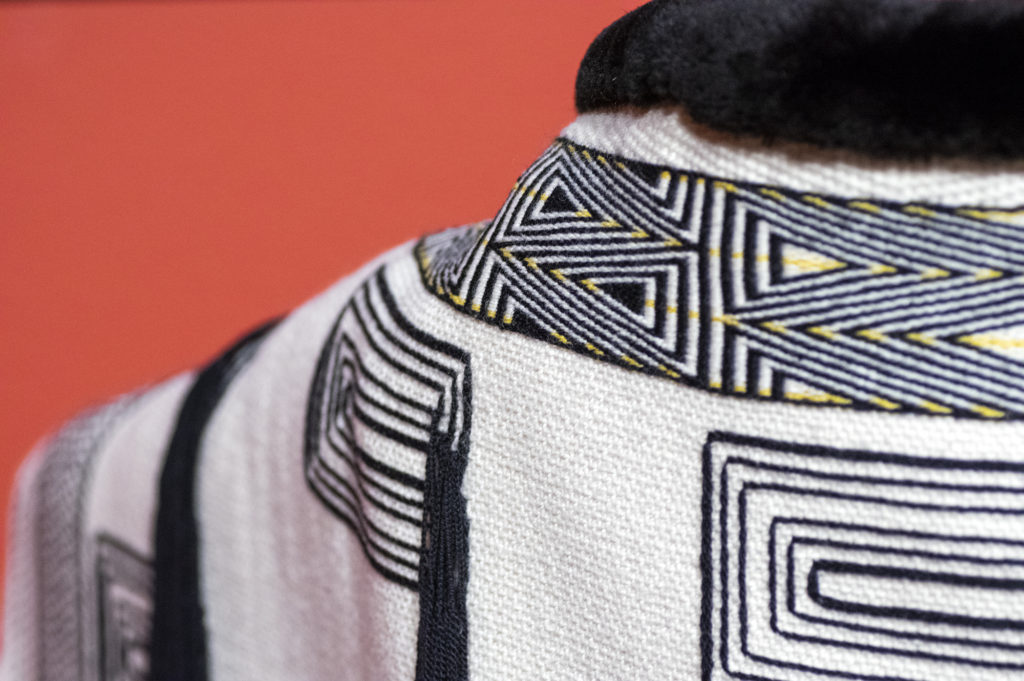
Netflix’s “Cheer”
redefines stereotypes
Review by Halle Nottage
eader,” it is typical for the perfect-bodied, blonde-bombshell, pompom waving ditz to come to mind.
The ever-present sideline performer yelling, “go team, go!” while jumping up and down in their tiny mini skirts and crop tops.
However, after watching the mini docu-series “Cheer” on Netflix, my entire perspective on what it means to be a cheerleader changed.
This six-episode series follows the journey of the nationally renowned, tiny Navarro Community College cheer team out of its tiny town of Corsicana, Texas, on their way to the national cheerleading competition in Daytona Beach, Florida.
Despite being from a junior college, Navarro CC has won 14 National Championships, 13 during the filming of the show, as well as five Grand National Championships, making them somewhat of an enigma amongst the cheerleading community.
So, the pressure was very much on during the making of this series to capture their 14th title.
Throughout the series, the private lives of several of the cheerleaders are looked into, as well as the coaches and several other people whose lives were more or less oriented around cheer.
This gives an incredibly interesting perspective on what it means to be a cheerleader, especially when it comes to the idea of being “perfect,” as it becomes evident that many are far from it yet still manage to be the best they can be for their team and themselves.
Furthermore, the show helped redefine the idea of what it means to be a cheerleader, and helps show the true, real and talented athletes that they really are, rather than the stereotype that so many believe to be true.
It puts on display the sacrifices they make in order to become the best athletes they can, as well as the best people they can be and is a wonderful ode to humanity and athletes as a whole.
All in all, I would highly recommend this series to anyone. It speaks to what it is to be a true, raw athlete, what it means to make hard sacrifices, how to overcome all types of adversity, and ultimately what it means to be a cheerleader.
This show does a beautiful job piecing together the journey that this team goes through in order to compete at Daytona, and puts on display the brilliance of their athleticism, and ability to get through anything, making it incredibly inspirational.
The show “Cheer” is not just for cheerleaders, it is for anyone who wants to learn what it means to be a driven, cutthroat athlete, and for that reason alone, it is a show for everyone.
Movie Review: ‘One Child Policy’
Review by Saki Kambe
Whenever I finish watching movies that are disheartening, I always get this “meh” feeling, then I question whether watching the film was a good choice. Most of the time, I cannot articulate my thoughts very well, either.
While I need to admit that this movie, “One Child Nation,” did in fact, leave me with a certain level of grief, it was “whatever” because if it weren’t for this movie, I would have been missing out on so much that happened during that 35 years in China. I’m relieved that I am finally up to date on China’s population control plan.
“One Child Nation” is about China launching the One Child Policy in 1980, which ended five years ago in 2015. For those that don’t know, One Child policy forced all the families in China only to have one child per family. The exception were rural areas that needed workforce for farm work.
The whole purpose of this policy was so that the nation won’t starve from overpopulation, which was expected to happen if the population kept increasing.
One Child Policy was an odd policy I learned about in history textbooks in middle school. I never gave it another thought. and it never came to my mind more or less than that. However, this documentary film walks you through what happened during that 35 years, in a series of interviews with Chinese people that lived with that policy. The interviewees were the Director Nanfu Wang’s family members, the officials that carried out the order, and a couple that have been researching the policy for over 10 years.
Wang flew to China with her son to interview only with her video camera that was not for professional use. Other staff didn’t come with her so she could get the raw voices from people. This made the film engaging as it captured first-hand tension between interviewees and Wang’s standpoint.
Revealed were the long-time untold, real and harsh stories that haven’t been public about China’s success in putting a lid on its overflowing population. I have to say all this that went on behind the scene needs to be heard, no matter how sad it can feel.
Watching this film will help you perceive the One Child Policy in ways that you haven’t before.
As much as this sounds cliche, there is no denying that is was a traumatic social experiment that China launched, and this will remain as truth whether we like it or not. I highly recommend watching it to educate yourself further on the policy.
One Child Nation is an Amazon Prime Original movie, so it is only available on Amazon Prime Video.



